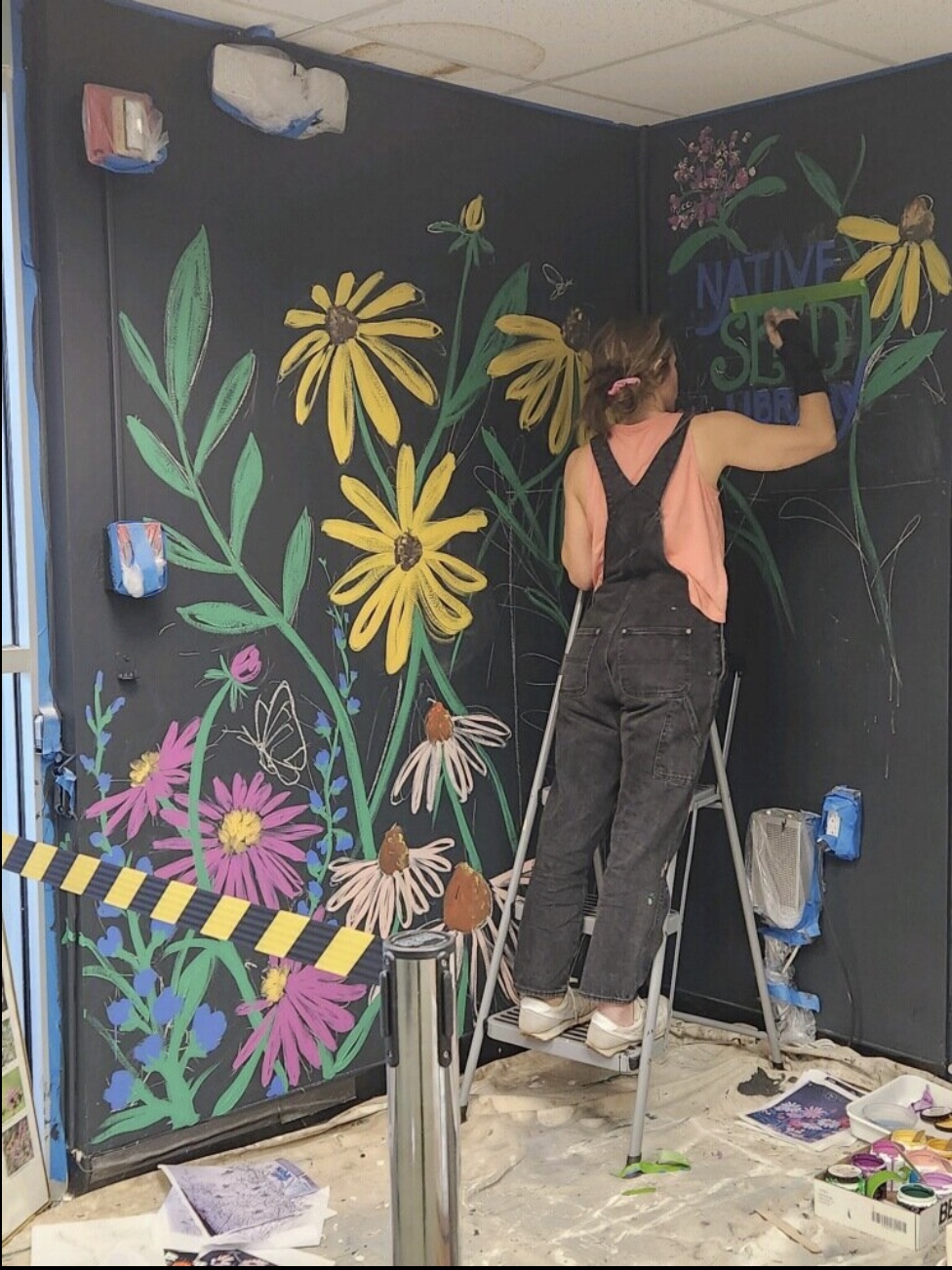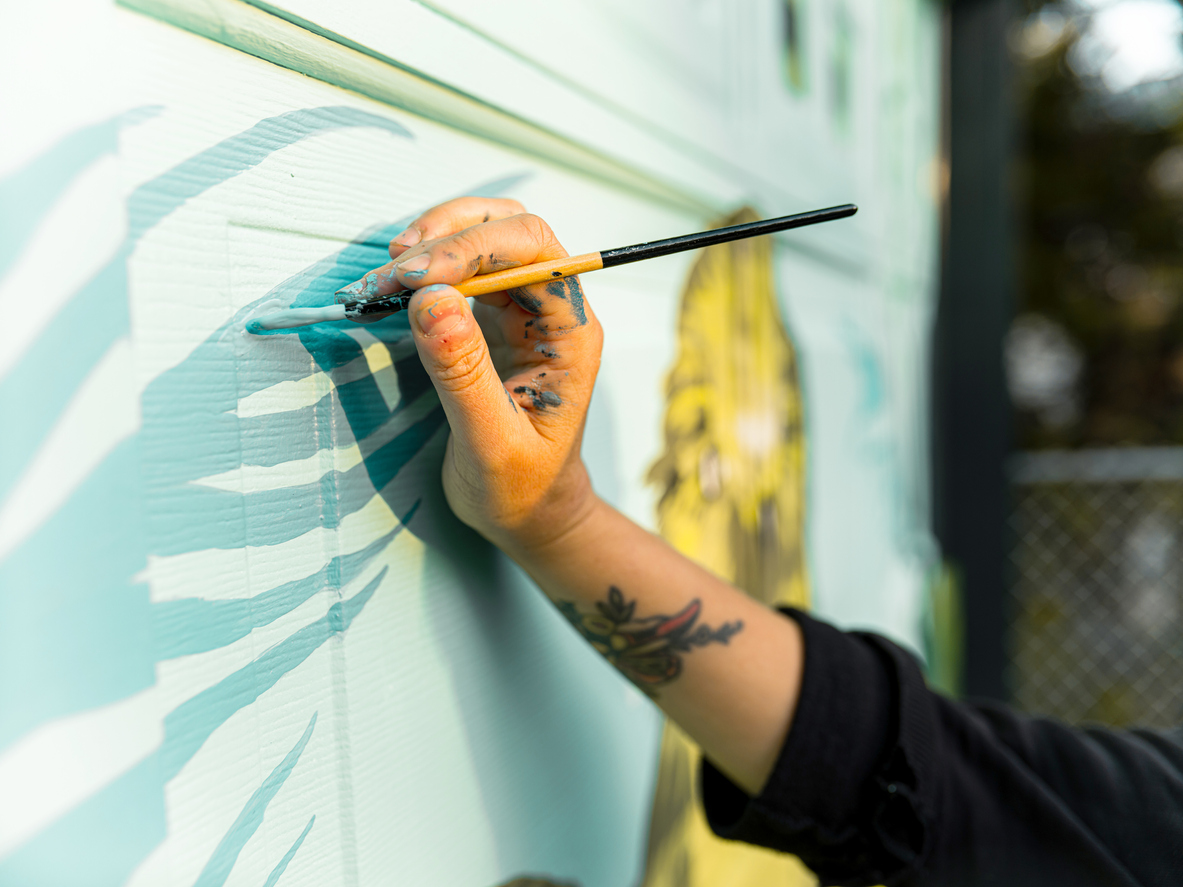

We may earn revenue from the products available on this page and participate in affiliate programs. Learn More ›
Many home decorators have faced the conundrum of what to do with a large empty wall. Instead of staring at a blank space, consider painting a mural for a personalized design statement. According to Zillow’s 2024 home trends report, murals are gaining popularity. The report cited an 18 percent increase in mural mentions in their home listings.
“Murals elevate the aesthetic appeal to any space in an expressive way that is truly one-of-a-kind,” says professional artist Meg Solebello, the owner of The Cranford Creative in Cranford, New Jersey. She says, “A mural serves as a focal point in a room, grabbing attention and adding visual interest.”
Solebello, a former NYC advertising creative turned professional painter, says murals connected with her “deep love for painting large, fast, and loose.” Those who can relate may want to try painting their own. Since a coat of paint will cover up a project gone wrong, it’s a low-stakes DIY risk that even amateur artists can give it a go without much worry. Get started with the following helpful tips for how to paint a mural.
RELATED: The Best Interior Paints for Every Room of the House, Tested and Approved
1. Evaluate the space.

Before getting started on any home project, it’s essential to evaluate the needs of the space. Consider how the area is used, the intended mood, logistics, and furniture placement. Solebello says not to eliminate smaller rooms or areas with limited natural light when considering a mural location. “A mural can create an illusion of space, visually opening up a room to make it feel larger and more inviting,” she says.
2. Come up with a concept.

The next step is to come up with a design concept. Consider factors such as skill level and the intended time commitment for a DIY mural. Beginners may want to opt for simpler designs or ones that are easier to map out, such as geometric designs with larger shapes that can be scaled with painter’s tape. Murals are one of four trends the designers at FrogTape brand painter’s tape see as big in 2024 (wainscoting, stand-out kitchen islands, and bold colors in unexpected places are the other three trends).
RELATED: The 5 Best Places to Buy Paint
3. Practice on a smaller canvas.

Solebello recommends practicing the design concept on a smaller scale first. “Before you start painting, plan your design in pixels or on paper,” she says. This type of drafting allows the artist to tweak their design as needed before jumping to a larger-scale paint project.
RELATED: 17 Easy Fixes for a Botched Paint Job
4. Pick a color scheme.

“You want to make sure the color palette is balanced and working together when selecting your paint swatches,” says Solebello. She recommends holding options against the current wall color to ensure they complement it and stand out enough. To find a palette, consider trying colors on the smaller canvas to ensure various tones play well together.
RELATED: Can You Paint Over Wood Stain?
5. Gather supplies.

The least expensive products may not be the best option when shopping for supplies. “High-quality paints and brushes will make a difference,” says Solebello, resulting in better coverage, durability, faster drying time, and cleaner lines and brush strokes. Other possible painting supplies are sandpaper for smoothing textured walls, painter’s tape, a mask, and a roller for larger sections. “Don’t forget a drop cloth to protect floors and furniture,” reminds Solebello.
RELATED: Painting Tools and Materials
6. Prep the wall.

A smooth and clean wall is the best canvas for a mural. “Before you open that can of paint, make sure the wall surface is clean, smooth, and primed,” says Solebello. “Remove any dirt, dust, or grease, and patch any holes or imperfections with spackle and sand down.”
RELATED: What Causes Paint Bubbling on a Wall—and How You Can Fix It
7. Scale the design.

Scaling a design includes ensuring the artwork is mapped out effectively on the wall. Some artists use a grid of squares to place the different elements in the correct part of the wall. To scale up the size of the design, artists can project the image for a more accurate transfer to the wall. Solebello uses white chalk to outline her basic shapes before getting started and painter’s tape to achieve clean lines.
RELATED: Solved! Can You Use Exterior Paint Inside?
8. Have fun with it.

Turn up the music and put on some overalls; it’s time to start painting. Don’t rush the process; take time to step back and evaluate with each addition. “Enjoy the creative process—embrace imperfections and learn along the way,” says Solebello. “Your mural is a reflection of your creativity and personal style, so let your imagination soar!”
RELATED: 13 Top Tips to Make Any Paint Job Go Faster
9. Create a removable mural.

For those who want an easy-to-move mural, such as renters, consider creating a removable mural. When one of her clients requested a mural they could move with them when they relocated, artist and blogger Haley Badenhop Leeper had to get creative. She used a Masonite wallboard as her canvas to accommodate their request. She also recommends polytab fabric and pre-primed canvas as other possible backdrops.
RELATED: How to Remove Paint From Everything
10. Try alternatives to drawing.

Stencils can be a helpful tool for those who feel overwhelmed by drawing simple shapes. Especially useful in children’s rooms, options like these woodland tree animals from TheStencilStudio on Etsy, make it simple to position and paint. And if stencils still feel too overwhelming, there’s wallpaper made to look like a mural, such as these from Graham and Brown.
11. Hire a pro.

Still not convinced? Whether it’s a lack of enough time it takes to paint a mural or skills, hiring a pro can be a great alternative. Consider the investment similar to that of fine art. A mural is a one-of-a-kind art piece that’s scale puts it on display for everyone in your home to see and appreciate.
